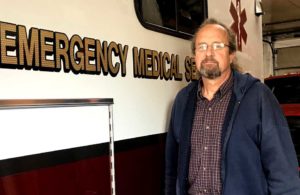ONE IDEA: DIVIDE COUNTY INTO 6 PARTS
Slow EMS Response Has
Towns Working Together
By JENNIFER HILL • Special to www.AllOTSEGO.com

About 20 months ago, Pittsfield Town Supervisor Mike Berthel’s 8-year-old son had a fever. When it spiked to 105.5, the father called 911.
He then waited 35 minutes before an ambulance arrived to take his son to the hospital. His son recovered quickly, but Berthel worried about the town Emergency Medical Services’ long response time.
What if someone had had a stroke and needed EMS immediately?
So he took action.
“I called Ed Lentz, New Lisbon’s supervisor, and said, ‘Ed, we have a serious problem,’” said Berthel.
“Twenty years ago, we had about 20 active volunteers in our (New Lisbon) EMS,” Lentz said. “We now have about six. The EMS’ response rate – sending an ambulance out in response to a 911 call – is 50 percent, meaning half the time a backup EMS squad needs to be sent instead of the local one.”
Backup squads might come from a neighboring town, making the average response time up to half an hour.
According to Lentz, decreasing membership include the state’s increasing training requirements, stricter regulations on dispensing of medicines and equipment at the emergency scene as well as people working in jobs far away from the town, unlike in the past when they were probably working at a nearby farm.
Berthel and Lentz contacted the supervisors of Morris, Edmeston, Burlington and Butternuts, EMS chiefs and fire district representatives to work on the problem.
“We knew other towns were having the same problems with their EMS,” said Berthel.
He knew because Pittsfield is in mutual aid arrangements with those towns, which means Pittsfield will provide backup aid to them if their EMS squads can’t respond to 911 calls – and vice versa.
But Pittsfield’s EMS service comes from the neighboring Village of New Berlin, which the Town of New Berlin and Pittsfield pay the village to use. That is because the Village of New Berlin’s EMS members are paid employees.
“But the mutual-aid arrangement breaks down,” Lentz said, “because the village can often provide the aid to towns, but the towns often can’t provide it in return.”
“The other towns are getting free rides,” Berthel said. “I raised taxes 12.1 percent, not just for EMS, but we pay New Berlin $37,500 annually to use their EMS. We need everyone to pitch in.”
“And there’s another problem,” he added. “New Berlin can only afford to pay their EMS for 16 hours a day, not 24 hours. That means, at night, they’re not available for backup.”
Berthel and Lentz have been working to compel towns to enter one-year contracts with the New Berlin-Pittsfield EMS and pay for the service, but the towns lack the funds to do so.
“The towns aren’t going to join right away because they can’t raise the money in time,” said Berthel. “And they’re going to have to raise taxes.”
The task force is also working on solutions to increase EMS members.
One solution the group is considering, Lentz said, is to keep the volunteer EMS infrastructure in place county-wide, with volunteers providing basic life support (BLS) and having paid staff to do the next level of care, Advanced Life Support (ALS).
“We would have that set up for six different regions of the county,” Lentz explained. “They would be on call 24/7, and when there’s a 911 call, BLS volunteers and ALS staff would responds.”
Lentz estimated the cost to be $1 million.
Another solution, which Essex County is implementing, is to have the county purchase “fly cars,” which are not fully equipped like ambulances, but ones that can respond to the scenes.
“EMS can give the immediate assistance needed while an ambulance arrives and then can transport the patient to the hospital,” Lentz said.
He and Berthel emphasized the quality of their EMS squads was top-notich.
“Our EMS squads are vitally important to our communities, to our lives,” Lentz said. “They volunteer their time and work under difficult conditions and they do amazing work.”
“It’s going to take a while to rebuild our squads and we need to do it immediately,” he added.

